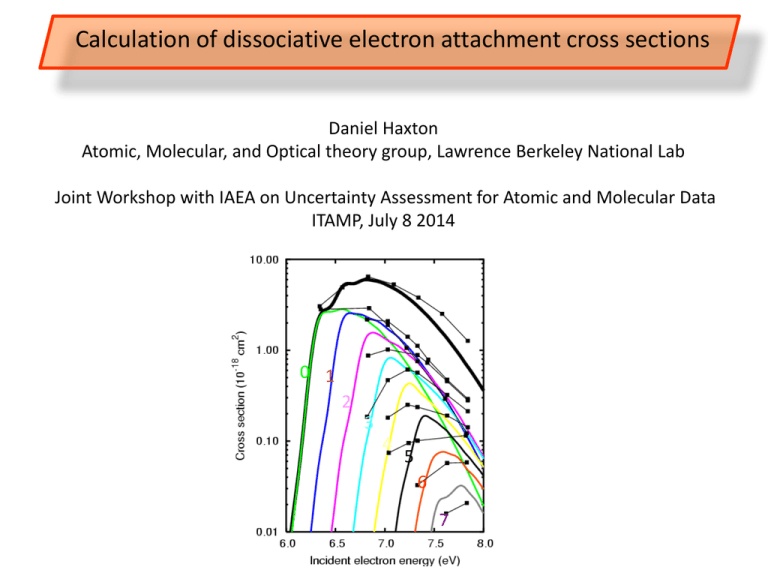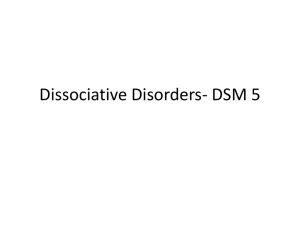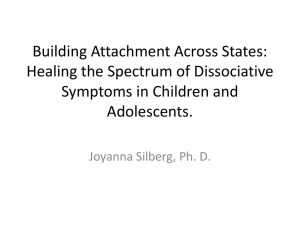Calculation of dissociative electron attachment cross sections
advertisement

Calculation of dissociative electron attachment cross sections
Daniel Haxton
Atomic, Molecular, and Optical theory group, Lawrence Berkeley National Lab
Joint Workshop with IAEA on Uncertainty Assessment for Atomic and Molecular Data
ITAMP, July 8 2014
0 1
2
3
4
5
6
7
Calculation of dissociative electron attachment cross sections
D.E.A. : AB + e- A- + B
Dissociative Electron Attachment (DEA) is a basic
physical process that may occur in plasmas, or in
everyday materials bombarded by ionizing radiation.
Reactive products: ions and radicals.
CF + e- C* + FH2 + e- H + HCHOOH + e- CHO2- + H
DEA leads to damage in
technological and biological
systems.
DNA damage via double strand breaks
Secondary electrons produced by fast
ion tracks in radioactive waste
Most energy deposited in cells by ionizing radiation is
channeled into free secondary electrons with energies
between 1 eV and 20 eV (B. Boudaifa et al., Science 287
(2000) 1658)
There has been a resurgence of interest in low-energy DEA to biologically relevant
systems - water, alchohols, organic acids, tetrahydrofuran, DNA base pairs, etc.
Basic Mechanism
1. e- + AB AB- (attachment)
2. AB- A + B- (dissociation)
Reverse of process 1 competes with process 2.
D issociativ e A ttach m en t
V
A + B
A + B
R
-
Basic Mechanism
Resonant processes include DEA
Nonresonant processes
Competition with vibrational excitation
For short-lived anion states, or those trapped in a potential well, the electron is
likely to detach, leading to vibrational excitation, e- + AB -> e- + AB*
Vibrational Excitation
“Boomerang Model”
A + B-
V
Dissociative Attachment
V
A+B
A + B-
A+B
R
R
Attachment and detachment probability is proportional to intrinsic width Γ of state
In the Born-Oppenheimer picture the resonance is a metastable state with energy
Summary - Basics
Dissociative electron attachment is described by TWO STEPS
Big picture: calculating FIRST STEP (attachment) is relatively easy.
If second step (dissociation) goes 100% (survival probability is 100%), then calculating
second step is not necessary to get total cross section.
Survival probability (and branching ratios) associated with second step may be VERY
DIFFICULT to calculate requiring major effort, if the polyatomic nuclear dynamics is
complicated.
So if the molecule takes a time tdiss to dissociate, the cross section depends on the width as
Summary - Basics
So uncertainty in dissociative electron attachment (DEA) cross section depends upon
survival probability
Survival probability given roughly by ratio of DEA to vibrational excitation
So prior knowledge of this ratio (from experiment or theory) should affect uncertainty in
DEA cross section.
( Isotope effect is also due to survival probability )
Different initial and final states, different uncertainty
DEA to H2O occurs via three different
states and leads to different final channels
with VASTLY different cross sections
1500
H-
Can get within 5%
200
O-
Within 50%
1/100th experimental result
Don’t even have a theory
6
OH-
Angular distributions
Combination of experiment and theory allows us to determine that the molecule
dissociates into the three-body channel via scissoring backwards
10
Angular distributions
Our interest currently is in angular distributions because they can tell us about dynamics.
Combination of experiment and theory allows us to determine that the molecule dissociates
into the three-body channel via scissoring backwards
11
Angular distributions
Our interest currently is in angular distributions because they can tell us about dynamics.
Combination of experiment and theory allows us to determine that the molecule dissociates
into the three-body channel via scissoring backwards
12
Angular distributions
Our interest currently is in angular distributions because they can tell us about dynamics.
Combination of experiment and theory allows us to determine that the molecule dissociates
into the three-body channel via scissoring backwards
13
Angular distributions
Acetylene
AXIAL
RECOIL
30 DEGREES
MORE
ELABORATE
TREATMENT
14
Calculations / experiment indicate breakup at ~30 degrees H-C-C bond angle
consistent with Orel and Chorou PRA 77 042709
Complex Kohn Method for Electron-Molecule Scattering
Complex Kohn Electron-Molecule
Scattering Code: Developed 1987-1995
T. N. Rescigno, A. E. Orel, B. Lengsfield, C.W. McCurdy
Lawrence Livermore National Lab, Lawrence Berkeley National
Lab
The “Kohn Suite” consists of scattering
codes coupled to MESA, a flexible
electronic structure code from Los
Alamos written in the 1980s and no
longer maintained.
i, ,
Continuum
Functions
l
h , jl
l < » 12
Quantum
Chemistry
Complex Kohn Variational Method: Stationary principle for
the T-Matrix (scattering amplitude), Walter Kohn
Complex Kohn Method for Electron-Molecule Scattering
3 parts of wave function for Kohn method in usual implementation.
Similar capabilities as UK R-matrix. Only in particular situations are there significant
differences in Kohn or R-matrix capabilities.
Complex Kohn Method for Electron-Molecule Scattering
Limitations of Present Capabilities
Small size of Systems – Small Polyatomics 6-10 atoms maximum but
only limited target response for more than ≈5 atoms
Highly Correlated Target States only for smaller systems – strongly
target states ≈ 5,000- 10,000 configurations
Energies < ≈ 50 eV and low asymptotic angular momentumset for
inner region of continuum functions
Poor Computational efficiency – Recently removed the limit of 160
orbitals, but serial calculations with legacy code require weeks of
computation – No parallel versions of either structure or scattering
codes.
NEW IMPLEMENTATION HAS BEEN PLANNED (Rescigno, McCurdy,
Lucchese)
Complex Kohn Method for Electron-Molecule Scattering
But the future looks promising for
calculating total widths (lifetimes).
Advancements in Kohn suite – McCurdy Rescigno Lucchese
Electronic structure methods for metastable states (SciDAC project)
It’s the survival probability that’s the problem.
Dissociative Attachment to CO2
e- - CO2 DEA and vibrational
excitation have been studied since
the 1970s
4 eV 2u shape resonance produces O- and
vib excitation
8.2 eV 2g Feshbach resonance produces O-
13 eV Feshbach resonance produces O-
Schulz measured O2- from an 11.2 eV
resonance in 1970s
Three DEA peaks identified by Sanche in
CO2 films at 8.2 eV 11.2 eV and 15 eV in
2004
Chantry (1972) and Fayard (1976)
Dissociative Attachment to CO2
DEA is minor channel; mostly vibrational excitation.
1.5 x 10-15 cm2 total cross section
1.5 x 10-16 cm2 vibrational excitation
McCurdy Isaacs Meyer Rescigno PRA 67, 042708 (2003)
DEA cross section: 1.5 x 10-19 cm2
Dissociative Attachment to CO2
Width of (one component of the) resonance is very large when molecule is bent.
STRONG effect of lifetime on final breakup channel.
McCurdy Isaacs Meyer Rescigno PRA 67, 042708 (2003)
Dissociative Attachment to CO2
Feshbach
resonance
conical
intersection
CO2- shape
resonance
CO2
ground
state
(CAS + single and doubles CI on both neutral and anion states)
Dashed = neutral, solid colored = anion
3 components of O2P make a 2
resonance and a
2virtual state
Proposed Mechanism: Bend to stay on lower
cone and dissociate to ground state products
2A’ + 2A” states upon bending and stretching
6
6
5
5
4
Energy (eV)
Energy (eV)
2
u
3
4.35 eV
θOCO = 180o
2
4
dissociation on 2A’
3
θOCO = 140o
2
1
1
0
2
3
4
5
6
0
2
OC---O Distance (bohr)
Moradmand et al. Phys. Rev. A 88, 032703 (2013)
3
4
5
OC---O Distance (bohr)
6
24
NO2
Dissociative Recombination of NO2+ + e+
NO2 ground neutral
NO2 excited states
Calculation done blind, no
experiment now or then
Step 1: Identify candidate states!
Attachment at zero electron energy.
Work done with Chris Greene at JILA, University of Colorado Boulder
Dissociative Recombination of NO2+ + eCandidates for direct DR
Dissociative Recombination of NO2+ + eSimple estimate of cross section as function of energy
Dissociative Recombination of NO2+ + e-
Dissociative Recombination of NO2+ + ePut the pieces together
Dissociative Recombination of NO2+ + e-
The result
Highly sensitive to position of
resonant states in this case.
Dissociative Attachment to H2O
3 resonance states, with multiple products from
2B
each O- production
1
2B
-
H production
2
2A
1
2B
2A
1
C. E. Melton, J. Chem. Phys., 57, 4218 (1972)
H2O + e- H2O- (2B1, 2A1, 2B2)
{
1
H- + OH (2)
H- + OH (2)
H + H + OH2 + O-
Dissociative Attachment to H2O
Calculations have Revealed Different
Dynamics of the Resonances in H2O
1. H- is produced from the 2B1 resonance directly
1. O- production from 2B2 resonance comes from passage
through conical intersection to 2A1 surface.
2. O- production from 2A1 comes from three body breakup O+H+H.
Dissociative Attachment to H2O
A Complete ab initio Treatment of Polyatomic
Dissociative Attachment
1.
1.
Electron scattering: Calculate the energy and width of the resonance for
fixed nuclei
–
Complex Kohn calculations produce
–
CI calculations with ~ 900,000 configurations produce
–
Fitting of complete resonance potential surface to dissociation
(r , R , )
E R (r, R, )
Nuclear dynamics in the local complex potential model on the anion
surface
V anion E R ( r , R , ) i ( r , R , ) / 2
–
–
Multiconfiguration Time-Dependent Hartree (MCTDH)
Flux correlation function (energy resolved projected flux) calculation of DA
cross sections
Dissociative Attachment to H2O
Complex Potential Energy Surfaces
V(r1, r2, ) = ER - i/2
r
r2
1
= h/
is lifetime
Dissociative Attachment to H2O
Local complex potential model
Dynamics on complex potential energy surface.
In general this theory is sufficient for DEA. Derivation: given L2 approximation to
resonant state, φ, define effective Hamiltonian for that state. Feshbach partitioning:
Dissociative Attachment to H2O
Local complex potential model:
HOWEVER are many systems requiring more elaborate (nonlocal)
treatment of effective operator – Horacek, Houfek, Domcke, others, e.g.
Electron scattering in HCl: An improved nonlocal resonance model
Phys. Rev. A 81, 042702 (2010)
J. Fedor, C. Winstead, V. McKoy, M. Čížek, K. Houfek, P. Kolorenč, and J. Horáček
Complete 2B1 (2A’’) Potential Surface
= 00
150
-
O + H2
700
OH +H
-
350
104.50
1250
OH +H
1500
-
1800
r1 O
H
38
r2
H
Dissociative Attachment to H2O
Triatomic rovibrational dynamics calculated with
Multiconfiguration Time-Dependent Hartree Method
Adaptive method capable of handling
multidimensional vibrational dynamics
E.g. malonaldehyde 24 atoms
H.D. Meyer et al, University of Heidelberg
Cross section from energy resolved projected flux.
Significant but manageable expense involved in
computing a double Fourier transform.
Cross Sections for OH vibrational states compared with
experiment
5.99 vs 6.5 10-18 cm2
0
1
2
3
4
5
6
7
D. S. Belic, M. Landau and R. I. Hall, Journal of
Physics B 14, pp.175-90 (1981)
40
Calc. Shifted by in incident energy by +0.34 eV
Dissociative Attachment to H2O
Dissociative Attachment to H2O
H- from 2A1 (middle peak)
~1 x 10-18 cm2 but overlaps 2B1
2B
1
~5 x 10-19 cm2
2A
1
Dissociative Attachment to H2O
Total O- production all states
We got lucky with 2B2
Very happy with this level
of agreement for 2A1
Very little O- from 2B1. . .
even with Renner-Teller
coupling to 2A1. . .
subtleties of PES?
Conclusion
IF we assume that DEA is driven by the direct, resonant process THEN the
source of major uncertainty is the survival probability i.e. uncertainty in
DEA is a function of ratio of vibrational excitation to DEA, and i.e.
uncertainty in DEA is function of isotope effect, so as long as these are
known a priori, from experiment or theory, even with low accuracy, the
model should give higher uncertainty in the theoretical result. Equivalently
if the width is known to be large. Or if the width is known to be large in
certain geometries and there is a decent chance of sampling those
geometries.
ALSO the precise energetics MAY give additional sensitivity to error
Atomic, molecular, and optical theory group at LBNL
CW McCurdy TN Rescigno
CY Lin
J Jones
X Li
CS Trevisan
AE Orel
B Abeln
Z Walters
Complex Kohn Method for Electron-Molecule Scattering






